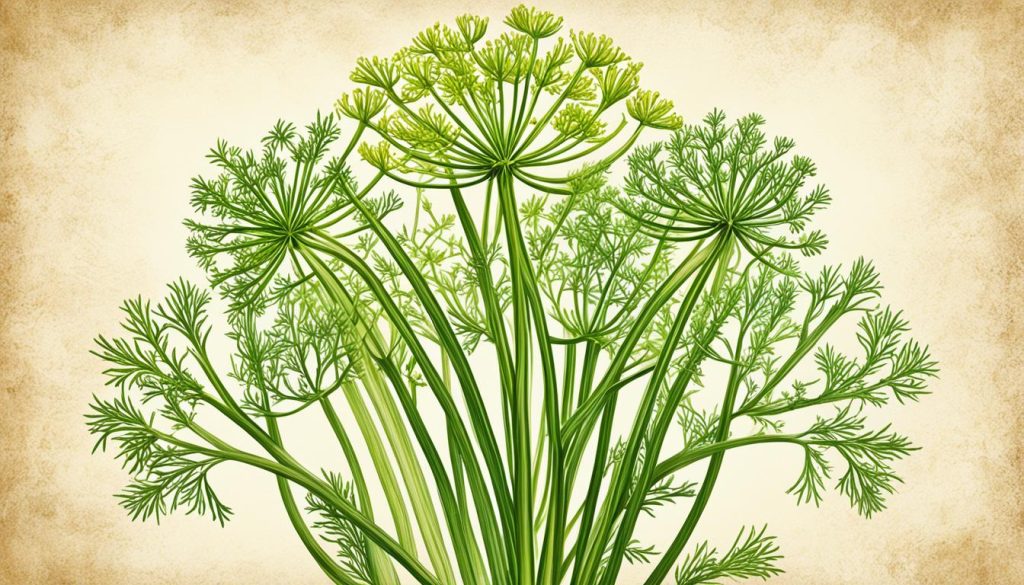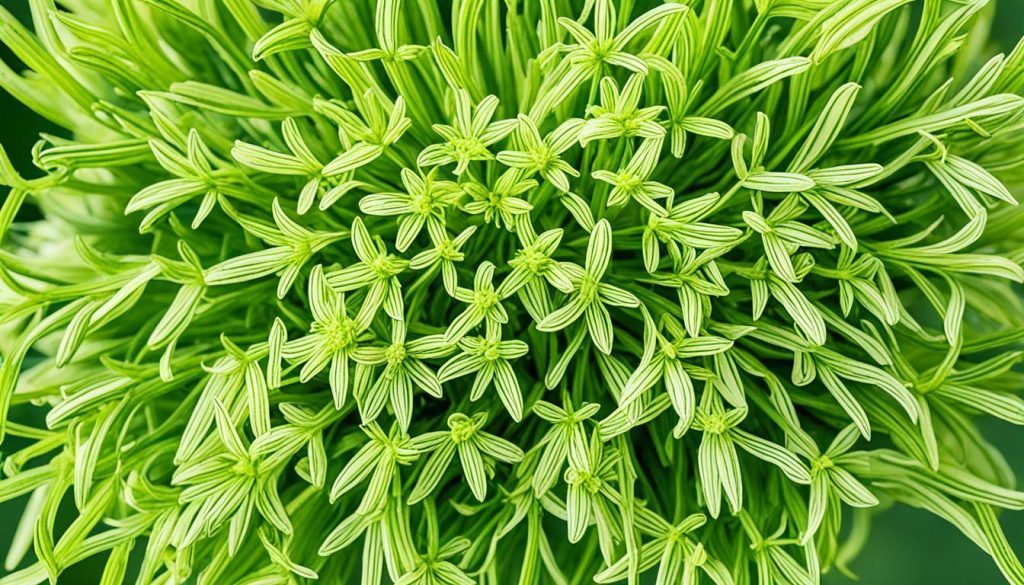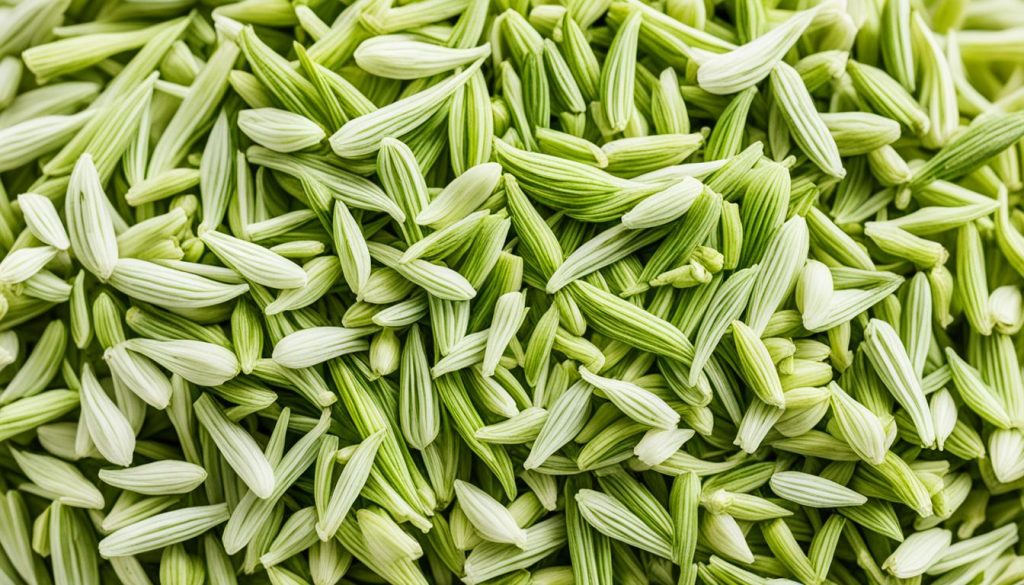I love finding new ingredients to use in cooking. Fennel caught my eye recently. It’s a plant with a unique taste. From its crunchy base to its fragrant leaves and seeds, fennel can make many dishes better.
Fennel comes from the Mediterranean. It’s been important in Italian, Greek, and Middle Eastern cooking for a long time. Now, chefs and home cooks worldwide use it for its rich flavor.
Fennel is good for your health too. It might help with digestion, ease cramps, and boost antioxidants. This guide will show you how to use fennel from start to finish. It’s a great way to add more health to your meals.
An Introduction to Fennel
Fennel is a tasty and versatile herb that has been around for centuries. It belongs to the Umbelliferae family, which also includes carrots, parsley, celery, and dill. Its history goes way back to ancient times in the Mediterranean.
Fennel’s History and Origins
Wild fennel was loved by ancient Egyptians, Greeks, and Romans for its healing powers. Its unique taste and smell were key in traditional cooking. Over time, cultivated fennel, or “sweet fennel,” became a staple in French and Italian cooking.
Fennel’s Culinary Versatility
Now, fennel is used in many dishes, from salads and soups to sausages and absinthe. It’s a great addition to any kitchen, fitting well in both sweet and savory recipes. Fennel adds a special anise-like flavor that can make your meals stand out.

“Fennel is a versatile ingredient that can elevate a dish from ordinary to extraordinary. Its unique flavor profile and crisp texture make it a must-have in any well-stocked pantry.”
| Culinary Uses of Fennel | Examples |
|---|---|
| Salads | Fennel and orange salad, fennel slaw |
| Soups | Fennel and potato soup, seafood stew with fennel |
| Roasted Vegetables | Roasted fennel with garlic and parmesan |
| Sausages and Meats | Fennel-spiced pork sausage, braised lamb with fennel |
| Baked Goods | Fennel-infused bread, fennel cookies |
| Beverages | Fennel-infused gin, fennel-based absinthe |
The Unique Flavor of Fennel
Fennel is a special herb with a unique taste. It has a sweet, earthy flavor that is similar to licorice but gentler. This comes from a compound called anethole, also found in anise.
When cooked, fennel gets sweeter and becomes a great addition to many dishes. It tastes like a mix of gentle licorice, warm anise, and fresh herbs.
Fennel’s flavor profile is a delightful dance of sweetness, spice, and a whisper of licorice – a true culinary delight.”
Fennel is loved in many cuisines, from Mediterranean to Asian. It can be roasted, sautéed, or eaten raw. Its taste and smell add depth and intrigue to dishes.

Using fennel’s unique flavor can make your cooking special. By understanding its taste, cooks can make dishes that are exciting and pleasing.
Fennel: Vegetable or Herb?
Many people wonder if fennel is a vegetable or an herb. The answer is, it can be both. The bulb, stalks, and leaves are often used as a vegetable. The seeds are used as a spice or herb.
The Difference Between Fennel and Anise
Fennel and anise are similar plants with a licorice-like flavor. But, they have some differences:
- Fennel tastes milder and sweeter than anise’s strong licorice flavor.
- Fennel is used in many dishes, like salads and seafood. Anise is mostly used in baked goods and liqueurs.
- The fennel bulb is eaten as a vegetable. Anise seeds are used for flavor.
| Characteristic | Fennel | Anise |
|---|---|---|
| Flavor | Mild, sweet, licorice-like | Stronger, more pungent licorice-like |
| Culinary Uses | Versatile, used in a wide range of dishes | Primarily used as a flavoring in baked goods and liqueurs |
| Plant Parts Used | Bulb, stalks, leaves, and seeds | Seeds only |
Fennel and anise may seem similar, but they are different plants. They have unique flavors and uses in cooking. Knowing the difference can help you use fennel better in your recipes.

Fennel’s Nutritional Benefits
Fennel is a tasty and versatile herb. It makes food better and is full of nutrients. It has a lot of dietary fiber, over 3 grams per cup. It’s also packed with vitamins and minerals like vitamin C, potassium, and manganese.
Fennel is great for your gut health. Its fiber helps with regular bowel movements and eases irritable bowel syndrome symptoms. It also has compounds that can lessen inflammation. This is good for people with period cramps or colic.
Fennel’s Health-Promoting Properties
Fennel does more than help your digestion. It has antioxidants that protect against chronic diseases. These phytochemicals may fight cell damage and lower the risk of cancer and heart disease. Fennel’s nutrients make it a key part of a healthy diet.
Adding fennel to your meals can boost your health and taste. It’s a smart and tasty choice for anyone looking to eat better.
Incorporating Fennel into Your Diet
Fennel is easy to add to many dishes. It brings a special licorice taste and crunchy feel. You can use it in both savory and sweet dishes.
Fennel in Recipes
You can slice, dice, or roast the fennel bulb for many recipes. Add it to potato soups, grilled foods, pizza, or salads. It goes well with citrus fruits, olives, and tomatoes, perfect for Mediterranean dishes.
Fennel seeds are also useful. They’re often in sausages, spice blends, and teas. They add a warm, sweet taste to your food.
For those wanting to learn how to use fennel, the stalks and leaves are great. Use them like celery in soups, stews, and stir-fries. They add a unique crunch and flavor.
| Fennel Preparation | Culinary Uses |
|---|---|
| Fennel Bulb | Sliced, diced, or roasted in soups, salads, grilled dishes, and pizza |
| Fennel Seeds | Sausages, spice mixes, and teas |
| Fennel Stalks and Leaves | Substitute for celery in soups, stews, and stir-fries |
Try different fennel in recipes to explore new tastes and health benefits. This plant is very versatile.

The Many Forms of Fennel
Fennel is a versatile herb with many forms. Each form has its own uses and benefits. You can enjoy it in teas, sausages, and more. It’s great for your health and taste.
Fennel Tea: A Digestive Delight
Fennel tea is made by steeping fennel seeds in hot water. It’s known for helping with digestion and reducing bloating. Drinking it can soothe your digestive system.
Fennel Oil: Aromatherapy and Herbal Remedies
Fennel oil comes from fennel seeds and has a strong anise flavor. It’s used in aromatherapy to help you relax. It’s also found in herbal remedies and health products.
Fennel Sausage: Savory and Sweet
Fennel sausage is a type of pork sausage flavored with fennel seeds. It has a sweet and savory taste. This sausage adds depth to many dishes.
| Fennel Product | Key Features | Common Uses |
|---|---|---|
| Fennel Tea | Made from fennel seeds, has a soothing, anise-like flavor | Improves digestion, reduces bloating, can be enjoyed as a calming beverage |
| Fennel Oil | Concentrated extract of fennel seeds, has a strong, aromatic scent | Used in aromatherapy, incorporated into herbal remedies and natural health products |
| Fennel Sausage | Pork sausage flavored with fennel seeds, has a sweet, licorice-like taste | Added to a variety of savory dishes to enhance flavor and complexity |
Enjoy fennel in many ways, like tea, oil, or sausage. Each form offers unique tastes and health benefits. Try fennel and see how it can improve your life.
Fennel
Fennel is a great vegetable with many uses. It goes from its crisp bulb to tasty seeds. It’s a key ingredient for cooks everywhere.
The fennel bulb is great sliced, diced, or roasted. It adds a sweet, licorice taste to dishes. It’s perfect in salads and also in soups and stews.
Fennel seeds are another great part of fennel. They’re used in sausages, spice mixes, and teas. They help with digestion. You can also use them in baked goods like breads and cookies.
Whether you use the bulb or seeds, fennel opens up new flavors. It can add a hint of licorice to salads or flavor sausages. Fennel is a must for cooks who want to try new tastes.
“Fennel is a fascinating herb that can transform a dish, adding a subtle yet captivating flavor that is both familiar and intriguing.”
Preparing Fennel for Cooking
Preparing fennel for cooking is easy and unlocks its full flavor. You can use it in salads, as a side dish, or to add depth to soups and stews. Just follow a few simple steps to get your fennel ready.
Step-by-Step Guide to Prepping Fennel
To prepare fennel for cooking, follow these easy steps:
- Trim the stalks: Cut off the stalks close to the base of the fennel bulb, reserving the feathery fronds to use as a flavorful garnish.
- Remove the root end: Slice off a thin portion of the root end to create a flat base for the fennel bulb.
- Peel away tough layers: Remove any tough or discolored outer layers of the fennel bulb.
- Cut the bulb: Cut the fennel bulb in half lengthwise, then cut out the triangular core.
- Slice or dice: The fennel bulb is now ready to be sliced, diced, or cooked as desired, whether you’re roasting, sautéing, or incorporating it into a recipe.
By following these simple steps, you’ll have perfectly prepared fennel ready to add its unique, licorice-like flavor to a wide range of dishes. Experiment with different ways of using this versatile ingredient to discover new culinary possibilities.
Fennel Recipes and Serving Suggestions
Fennel is great in many dishes, from soups to salads. It adds a special touch that makes meals better. I like to add it to potato soup or gratin for a unique flavor.
Roasting fennel with beets makes a great side dish. For a quick pasta topping, I sauté fennel with garlic and tomatoes. It’s also great with meats and fish, adding flavor to sausages or as a pizza topping.
Fennel’s versatility and taste always impress me. Shaving it for a salad with citrus and herbs is refreshing. There are so many ways to use this amazing herb in cooking.

